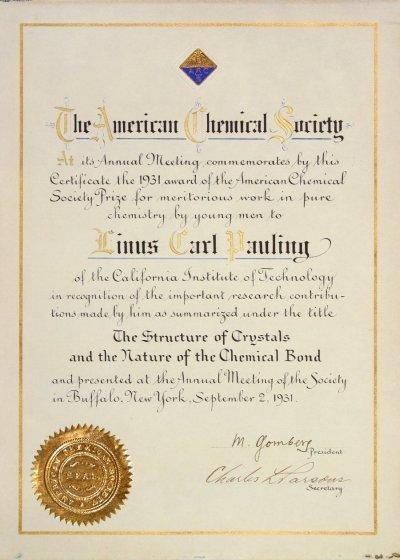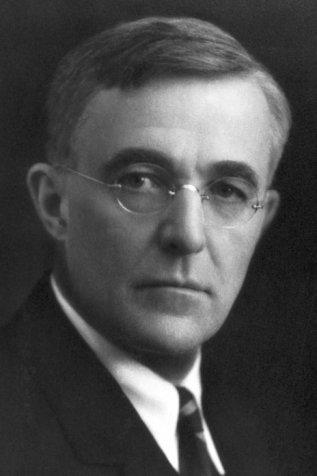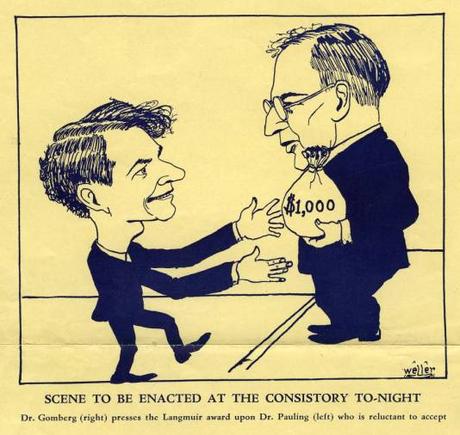
In 1931 Linus Pauling was early on in his career as a professor at the California Institute of Technology, and was deep into a program of research on structural chemistry that would prove revolutionary. Pauling was one of the brightest young minds that Caltech had seen to date, and the announcement that Pauling was to receive the inaugural Irving Langmuir Prize from the American Chemical Society served as further evidence of his extraordinary abilities. The first major award received by Pauling as an academic, the Langmuir Prize would be followed by countless additional decorations honoring a long and storied career.
The Irving Langmuir Prize, also known as the Pure Chemistry of the American Chemical Society Prize, was created by A.C. Langmuir, an industrial engineer who manufactured shellac and glycerine. First announced in early 1931, the $1,000 award was meant to serve as a form of encouragement and support for young chemists in the United States. The decision to honor Linus Pauling as the initial recipient of the award was made by a select committee of American Chemical Society members.

Irving Langmuir
A.C. Langmuir named the prize after his brother, Irving, a renowned scientist who would receive the Nobel Chemistry Prize in 1932 for his work in surface chemistry. In addition to his status as a Nobel laureate, Langmuir is today remembered by many for developing light bulbs that were more efficient and longer lasting than the Nernst Lamp model that had previously dominated the marketplace.
While Pauling no doubt appreciated Irving Langmuir’s practical work, his theoretical contributions made a far more profound impact on the budding young scientist, who began reading Langmuir’s papers while still an undergraduate at Oregon Agricultural College. As he noted in 1946,
I became deeply interested in molecular structure and the nature of the chemical bond in 1919, when I first read [G.N.] Lewis’ 1916 paper and Irving Langmuir’s papers on this subject.
One 1919 paper proved especially important. In it, Langmuir discussed his application of G.N. Lewis’ insights into chemical bonding and his observation that pairs of electrons can be shared by atoms in many substances. Importantly, Langmuir also used the article to put forth the idea that a full understanding of the chemical bond could not be arrived at through the simple application of a chemist’s or physicist’s training. Rather, the problem required a marriage of the two disciplines.
Titled “The Arrangement of Electrons in Atoms and Molecules” and published in the Journal of the American Chemical Society, Langmuir’s paper served as an inspiration to Pauling, who did indeed marry aspects of chemistry and physics in elucidating a new theoretical understanding of the chemical bond.
Twelve years later, Pauling was hard at work on several research projects that were driven by this stroke of inspiration. Most notably, Pauling had recently authored his landmark article “The Nature of the Chemical Bond. Application of Results Obtained from the Quantum Mechanics and from the Theory of Paramagnetic Susceptibility to the Structure on Molecules,” the first in a series of significant papers on the structure of the molecules. By the time that Pauling received his ACS award in September, he had already released the third installment in the series. Taking note of this dizzying array of productivity, Scientific American dubbed Pauling the “explorer of electrons” in a 1931 article.

Humorous editorial cartoon published in the “Double Bond Jr.,” a publication circulated at the Buffalo ACS meeting in September 1931.
Pauling was nominated for the Langmuir Prize by his Caltech mentor, A.A. Noyes. The director of the Gates Chemical Laboratory and a respected member of the American Chemical Society, Noyes’ views carried significant weight with his peers, and in his nomination letter of June 8, 1931, Noyes described Pauling as “the most promising young man with whom I have ever come in contact in my many years of teaching.” This hearty endorsement, combined with Pauling’s vita – which already listed more than fifty published papers – made the decision an easy one for the award committee.
Pauling, with his wife Ava Helen, received the prize on September 2, 1931 in Buffalo, New York. At the ceremony, A.C. Langmuir praised the body of work that Pauling had already compiled and accurately predicted that he would one day be a Nobel Prize winner. The Langmuir decoration proved to be a source of significant attention for Pauling. In one of a bevy of congratulatory letters that followed, former classmate W.E. Ramsey noted that “I knew you were a genius because you could solve my calculus problems which were always a mystery to me.” Likewise, University of Chicago chemist Thorfin Hogness recounted that he expected Pauling would win the award as soon as it was introduced.
In addition to raising Pauling’s profile, the financial support provided by the Langmuir Prize was especially significant as the United States was entering into the worst years of the Great Depression. Indeed, the $1,000 award that came with the prize was equivalent to a quarter of Pauling’s annual salary. Today, in recognition of its namesake’s interdisciplinary focus, the Irving Langmuir Prize is granted alternately by the American Chemical Society and the American Physical Society. Recipients now receive a cash award of $10,000.
As time moved forward, Pauling remained very active within the American Chemical Society, serving as president of the organization in 1949. He would also win several additional major awards offered by the ACS, including the Josiah Willard Gibbs Medal in 1946. So too did Pauling receive a great many decorations from regional chapters of the organization. In 1966, he was the recipient of perhaps the most noteworthy of these awards when the Oregon and Puget Sound sections presented him with the first Linus Pauling Medal for outstanding achievement in chemistry.
